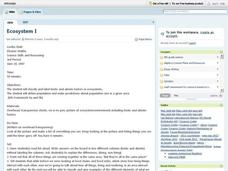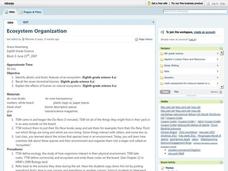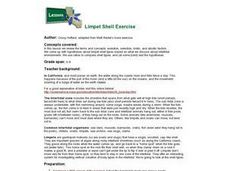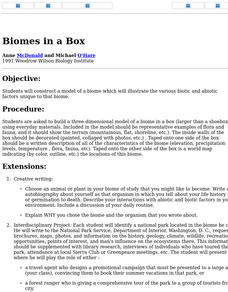Curated OER
Living and Nonliving Environments
In this ecosystem worksheet, students will distinguish between the abiotic factors and biotic factors shown in a diagram. Then students will correctly order the following: population, ecosystem, community, and organism.
Curated OER
Biotic and Abiotic Factors
In this biotic and abiotic factors worksheet, students complete 20 various types of questions related to biotic and abiotic factors. First, they write the vocabulary word that best completes the sentence. Then, students state an example...
Curated OER
Forest Fires
Students discuss the benefits and problems associated with fire. They discuss the role that fire plays in maintaining healthy ecosystems. Students brainstorm ways that fire can be harmful, such as damaging homes, communities, and...
Curated OER
Pond Water Survey
Students identify and describe various organisms living in a pond water environment. They describe the characteristics of living things. Students compare and contrast organisms created by asexual reproduction and sexual reproduction....
Curated OER
Using Abiotic and Biotic Parameters to Monitor Air Quality
Students identify the abiotic factors that influence a river or stream and the organisms that live in it. They measure several abiotic and biotic parameters to gauge water quality. Students examine the biotic environment by identifying...
Curated OER
What makes up YOUR Environment!
Students create their own land or water environment. They make their environment livable for all the different animals they collect to put in it. Students research the types of animals that they can have in their environment, and how...
Curated OER
TE Activity: Environmental Interactions
Learners design a web that shows the interactions between the living and non-living parts of the environment. They determine what an environment is and how engineers work together to solve problems. They complete a tally chart that they...
Curated OER
Flowering Phenology: How Do Plants Know When To Flower?
Students explore the biotic and abiotic factors that affect plant reproduction and the potential consequences of human activities on plant populations. The effects of urbanization are discussed as an influence in the consequences.
Curated OER
To Be or Not to Be - Abiotic/Biotic Factors
Students define and compare/contrast abiotic and biotic factors presented while using web cameras on the Web World Wonders website.
Curated OER
Forest Management ~ Diseases and Pests that Effect a Good Harvest Stand
The forestry presentation found here lists and describes a variety of tree diseases. A few unappetizing photos are included to show symptoms of some of these diseases, or the insects and fungi that cause them. If you have a class that is...
Curated OER
Species Interactions in the Yucatan Peninsula
Sixth graders explore how organisms interact with one another other in their environment. For this organism lesson, 6th graders understand abiotic factors and or biotic components of their environment. Students decide if the interactions...
Curated OER
Hands on Biome--Building
Students create a model biome. In this ecology lesson, students use materials to create a model biome. There is an extension activity that allows students to write about plants and animals and their specific biome.
Curated OER
A Walk in the Woods
Eighth graders observe and identify the different levels of the forest. In this forest zones lesson students observe, identify and name a variety of forest components and describe how humans impact the forest ecosystem.
Curated OER
Chewin' in the Chesapeake
Students examine a web page on food webs and select a habitat to research. In this research lesson students identify the organisms found in the food web and present their findings to the class.
Curated OER
Critters in Your Own Backyard
Learners identify various animals and their habitats, as well as their specific traits In this animal habitat lesson, students list animals they've seen in their backyard. Learners select one animal and do research. Students then answer...
Curated OER
The Principles of Ecology
In this ecology worksheet, students complete a word search by finding 21 terms associated with habitat, ecology, biosphere, and niche.
Curated OER
Ecosystem I
Young scholars classify and label biotic and a-biotic factors in ecosystems. They define population and make predictions about population size in a given area. They describe the a-biotic factors' importance and impact on the other...
Curated OER
Habitats, Abiotic v. Biotic
Young scholars explore and define ecosystem, ecology and habitat. They discuss abiotic and biotic organisms and the things needed for survival. After observing pictures of animals in their habitat, students compare and contrast...
Curated OER
Ecosystem Organization
Eighth graders engage in a lesson about ecosystems with the intention of looking at how it is organized. They cover the biotic and abiotic factors of an ecosystem while looking at the seven types of terrestrial biomes. Students write...
Curated OER
What Is In The Water?
Students investigate the biotic and abiotic factors that are found in an aquatic ecosystem. The emphasis is upon the investigation of present an projections of future water quality. Then students visit a local body of water to gather...
Curated OER
Biotic vs. Abiotic Factors
Students share their prior knowledge of the elements of the environment. In groups, they are introduced to the concepts of biotic and abiotic factors in a specific environment. They discover their effects on organisms living in the...
Curated OER
Limpet Shell Exercise
Pupils review the terms and concepts: evolution, selection, biotic, and abiotic factors. They come up with hypotheses about limpet shell types based on what we discuss about intertidal environments. Students use ratios to compare shell...
Curated OER
Martha Who?
Students explore how the number and types of organisms an ecosystem can support depends on the resources available and on abiotic factors, such as quantities of light and water, a range of temperatures, soil composition. They are...
Curated OER
Biomes in a Box
Students construct a three-dimensional model of a biome which illustrates the various biotic and abiotic factors unique to that biome. They use everday materials to represent the important characteristics of a particular biome and then...

























